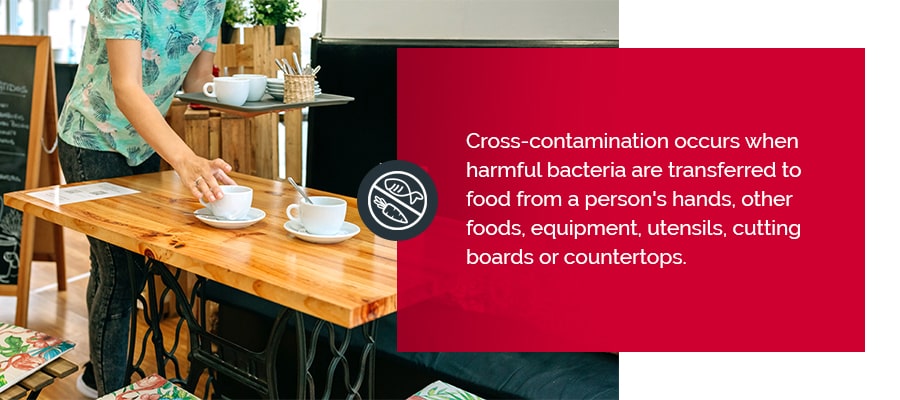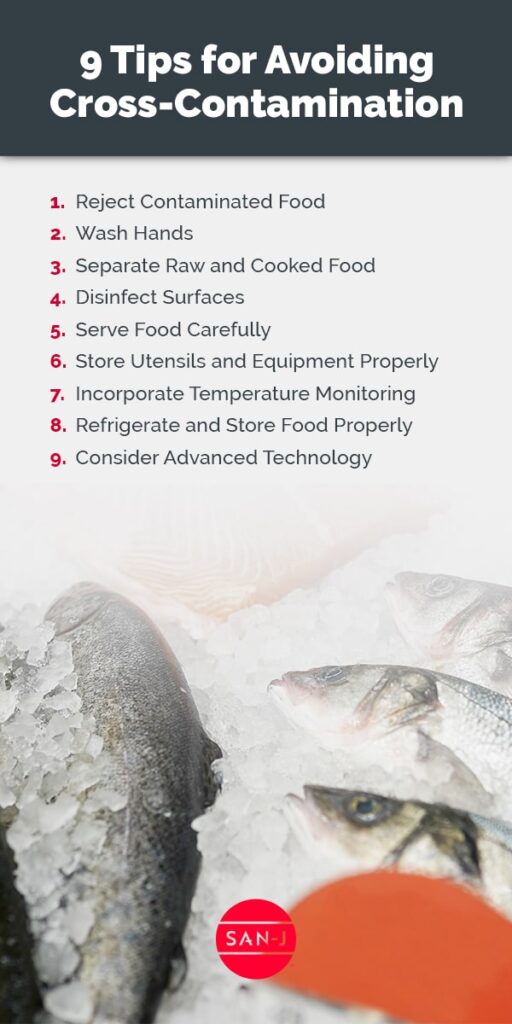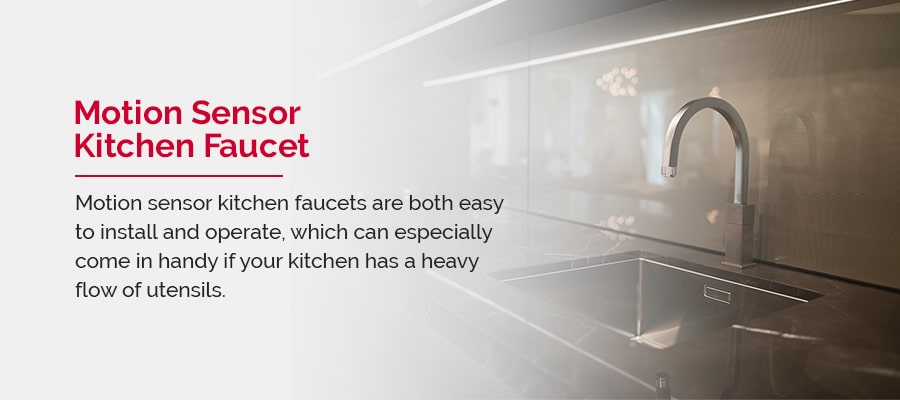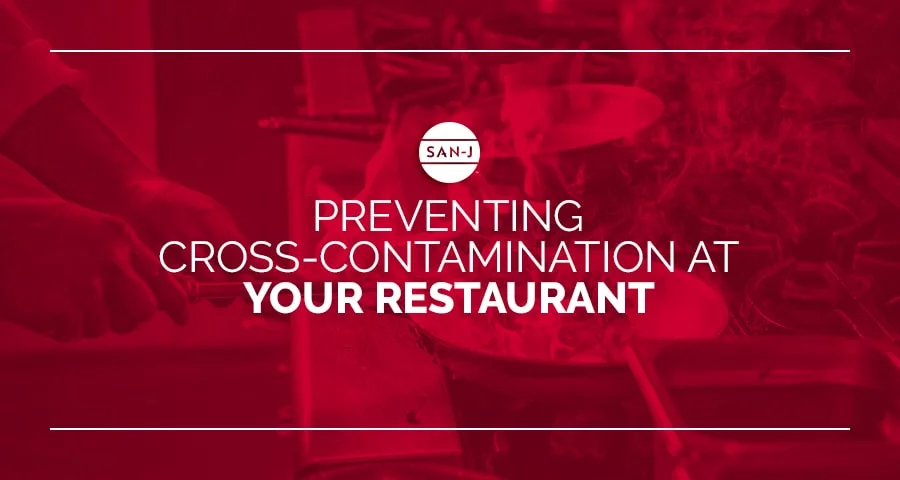When you work in a restaurant or other food service environment, ensuring the health and safety of your dishes, staff and customers is critical. Preventing cross-contamination plays a significant role in doing so. When you consider how often food comes in contact with various surfaces, utensils, equipment and other workers, this process shouldn’t be glossed over.
Cross-contamination can happen at nearly any point in the flow of food during your everyday operations. Thankfully, it’s easy to prevent when you know where and how it can happen. This article will teach you how to prevent cross-contamination in your restaurant with nine handy tips.

What Is Cross-Contamination?
Cross-contamination occurs when harmful bacteria are transferred to food from a person’s hands, other foods, equipment, utensils, cutting boards, or countertops. Some cross-contamination examples might include:
- Touching raw meat, then handling another food without washing hands between tasks.
- Wiping your hands on a food-soiled towel or apron between different food-handling tasks.
- Not changing gloves between handling different foods.
- Placing raw chicken on a grill so it’s touching a steak being cooked.
- Using unclean equipment like a can opener, slicer or utensil to prepare food.
- Storing sauce in an unclean container that formerly stored raw meat.
- Using the same work surfaces, utensils or cutting boards for both raw and cooked foods.
Cross-contamination can also involve ingredients with common allergens, like peanuts or gluten. So if a gluten-free food contacts an ingredient with gluten in it, you’ve contaminated the gluten-free item, and it’s unsafe to serve to a customer with dietary restrictions.
Preventing cross-contamination by separating food and keeping hands, surfaces and utensils clean helps prevent the spread of foodborne illness. Thankfully, there are simple yet highly effective practices you and your staff can follow to reduce the risk of cross-contamination.

9 Tips for Avoiding Cross-Contamination
Now that you know some ways food contamination can occur, what are some tips to avoid cross-contamination? From separating raw foods and cooked foods to frequently cleaning and sanitizing work surfaces, there’s a lot you can do to maintain a safe kitchen for you and your employees, as well as safe dishes for your customers. Below are nine practices to maintain a clean environment and help prevent the spread of foodborne illness.
1. Reject Contaminated Food
One of the simplest ways to help prevent cross-contamination in restaurants is to keep contaminated food from entering your establishment in the first place. Follow these tips to make sure you’re keeping contaminated food out of your operations during receiving:
- Ensure the food packaging is clean and intact. Reject any food products that appear dirty, leaking, water-stained or discolored.
- Ensure the packaging doesn’t have any holes, punctures, tears or other signs of damage.
- Reject any cans that appear rusty or dented or have swollen ends.
- Reject any food items if you spot signs of pests.
2. Wash Hands
Proper hand washing is one of the best ways to prevent the spread of germs from hands to food and from food to other items in the kitchen. It can also prevent the spread of bacteria from the restroom onto kitchen equipment or surfaces.
Remind your employees to wash their hands with hot water and soap after handling raw meat, poultry and seafood, after using the bathroom, and before handling ready-to-eat food. It’s recommended that you wash your hands for at least 20 seconds with soap and water, scrubbing between the fingers, the front and back of your hands, and under the fingernails.
Additionally, remember to dry your hands with a hand dryer or single-use paper towel rather than wiping them on your clothes. Chances are, you’ve been taught the importance of hand washing from a young age, but it truly makes a world of difference when maintaining a clean, safe restaurant environment for everyone.
3. Separate Raw and Cooked Food
Placing ready-to-eat foods on surfaces that have been in contact with raw foods like meat, eggs, poultry, and seafood can spread illness-causing germs to the cooked food. Following these tips can help ensure you’re separating cooked and raw foods:
- Use separate countertops for cooked and raw foods.
- Use multiple cutting boards — one for raw meats and one for fresh produce. Remember to replace these cutting boards when they start to crack, show excessive wear, develop tough-to-clean grooves or have extensive cuts from knives.
- Use separate utensils and plates for raw and cooked foods.
- Keep raw meat, eggs and seafood separate from other foods when transporting and refrigerating them.
- Ensure utensils, equipment, cutting boards, countertops, and other surfaces are clean before using them to handle raw or cooked foods.
4. Disinfect Surfaces
Cleaning and sanitizing equipment, utensils and work surfaces after every use is important to prevent cross-contamination. Soapy hot water is advised for most tools and surfaces, but commercial disinfectants may be required in some cases. Frequently touched items like cabinet knobs, refrigerator handles, and doorknobs should also be sanitized regularly.
Because it’s important for the health of staff and diners alike, restaurants are regularly rated on their cleanliness levels. While it’s sometimes difficult to find time to sanitize work areas, especially during busy dinner shifts, you’ll want to properly disinfect the kitchen after each shift at least. This includes before and after breakfast, lunch, and dinner.
Here are some precautions to take during the disinfecting process:
- Ensure there’s no food near the area you’re disinfecting.
- Wash all utensils, pots, pans, dishes, and cutting boards in a high-temperature dishwasher so they’re properly sanitized.
- Spray down surfaces with a chemical disinfectant, letting it sit for at least 10 minutes — or as long as directed — to allow it to kill all of the germs.
- Transfer all soiled cleaning cloths to the laundry and grab clean ones for the next shift.
- Wipe down any surfaces that are frequently touched but don’t require washing, like handles on food warmers, light switches, refrigerator handles, and drink dispensers.
5. Serve Food Carefully
When food comes into direct contact with surfaces — whether plates, utensils, or equipment — they become food-contact surfaces. It’s easy to contaminate these surfaces if you don’t handle them carefully. Here are some tips to help prevent cross-contamination when serving food to customers:
- Don’t touch any glassware, dishes, or utensils by the parts that come in contact with food, like the rim or interior of a glass, inside of a bowl, or tine-end of a fork.
- Hold dishes by the edge or from underneath, glasses by the bottom, middle or stem, and flatware by the handles.
- Never use bare hands to scoop ice or handle ready-to-eat food — use gloves, tongs, scoops, or deli sheets.
- Use different utensils when serving different foods.
6. Store Utensils and Equipment Properly
Any utensil, cutting board, or piece of equipment with a food-contact surface should be stored in a way that prevents the risk of contamination. This measure also applies to nonfood items like plastic utensils and napkins.
Here are some storage tips to keep in mind:
- Store any equipment or utensils that touch food at least 6 inches off of the floor.
- Store utensils with handles facing upward.
- Store cups and glasses upside down on a clean and disinfected surface.
7. Incorporate Temperature Monitoring
Monitoring food temperature can be another helpful way to ensure a clean, safe kitchen and food. When certain foods — especially cooked meats and fish — drop below a safe temperature, they can easily become a hotbed for harmful bacteria.
When the internal temperature becomes high enough to kill germs that can cause sickness, that indicates the food is safely cooked. Checking the temperature with a food thermometer is the only surefire way to tell whether the food has been safely cooked.
First, know how to place the thermometer properly in different foods to obtain accurate readings. For instance, in a roast, you’d place the thermometer in the middle of the meat while avoiding the bone. You should also familiarize yourself with the safe cooking temperatures for different types of foods. Here are some examples:
- Whole cuts of beef, pork, ham, lamb, and veal: 145 degrees Fahrenheit — allow the meat to rest for about three minutes before carving and serving
- Fish with fins: 145 degrees Fahrenheit, or until the flesh is opaque and can be easily separated with a fork
- Turkey, ground chicken and other poultry: 165 degrees Fahrenheit
- Ground meats, like pork and beef: 160 degrees Fahrenheit
- Casseroles and leftovers: 165 degrees Fahrenheit
Microwaving Tips
It’s also important to microwave food thoroughly. Make sure you follow the suggested cooking and standing times. When you allow the food to sit for a few minutes after microwaving, cold spots can absorb heat from hotter areas, cooking more thoroughly.
Knowing your microwave’s wattage is essential for food safety, as well — the higher the wattage, the faster it will cook food. You’ll typically find the wattage inside the door, in the owner’s manual, or on the manufacturer’s website.
If your microwave has a high wattage of 1,200 watts or more, use the minimum cooking time recommended. For a lower wattage in the 600-800 range, use the maximum cooking time recommended. When reheating food, you can use a thermometer to ensure the microwaved food reaches 165 degrees Fahrenheit.
8. Refrigerate and Store Food Properly
Maintaining a safe food temperature — and avoiding mixing it with food that isn’t up to temperature — can help prevent cross-contamination. Bacteria can quickly multiply when left at room temperature between 40 and 140 degrees Fahrenheit, also known as the “Danger Zone.” Try to keep your refrigerator at 40 or below and your freezer at 0 or below, throwing out food before it spoils.
If your fridge doesn’t include a built-in thermometer, you can keep a separate appliance thermometer inside of it to regularly check and monitor the temperature. Here are some other tips to keep in mind when storing and refrigerating food:
- Cover raw foods: Covering meat and other raw foods and isolating them from ready-to-eat foods can help prevent cross-contamination. Place raw meat, seafood, and poultry in sealed containers or plastic bags so their juices don’t drip into the refrigerator or onto other foods. Raw juices can contain harmful bacteria. It’s also best to store raw meat, poultry, and fish on the bottom shelf of the refrigerator.
- Marinate properly: Always marinate food in the refrigerator instead of on the counter. Any sauce used for marinating raw meat, seafood, or poultry shouldn’t be used on cooked foods unless it’s boiled right before use.
- Store and refrigerate cold foods quickly: Unpack and store all cold foods immediately, especially meats, right after they’re delivered. If you won’t be using the meat right away, you can store it in the freezer. Store eggs in their original cartons, refrigerating them as soon as possible, as well.
9. Consider Advanced Technology
Integrating advanced technology into your daily kitchen operations can be another great way to help prevent cross-contamination. Below are examples of restaurant technology that promote cleanliness for workers.
UV Light
Research has shown that ultraviolet (UV) light can destroy bacteria, mold, fungi, and viruses. With advancements in this technology, UV light can be used for cleaning purposes in food manufacturing facilities, restaurants, and other work settings.
UV light can be a helpful supplement to other cleaning procedures. It can help protect against any missed or improperly disinfected areas, allowing workers to identify the hardest-to-clean surfaces and areas around the kitchen. UV lights can also substitute chemical disinfectants.

Motion Sensor Kitchen Faucet
A motion sensor kitchen faucet can provide many benefits for your restaurant, including more efficient dishwashing, helping you and your staff maintain proper kitchen hygiene, and adding a stylish flair to your cooking space. Its touch-free faucet can help prevent cross-contamination, as there’s a reduced transfer of bacteria and germs from the handle to employees using it.
Motion sensor kitchen faucets are both easy to install and operate, which can especially come in handy if your kitchen has a heavy flow of utensils. As another perk, these faucets can help cut down on your daily water usage — the water supply turns off automatically when you remove the dish or hands from underneath the faucet.
Vegetable Cleaner Machine
An ultrasonic vegetable cleaner helps protect produce from carrying viruses and bacteria, thus preventing harmful toxins and microbes from reaching those who consume the produce.
When producing fruits and vegetables, farmers might use chemicals like pesticides and fertilizers. These can leave residues on the produce, which can stick around even if you wash them in the kitchen with plain water afterward. For this reason, a vegetable cleaner machine can be an excellent investment for your restaurant.
Even with packaged vegetables, there’s always a contamination risk from chemicals in packaging materials. An advanced vegetable cleaner allows you to thoroughly clean raw veggies and fruits, stripping your produce of harmful germs, dirt, and microbes.
Prevent Cross-Contamination With These Tips From SAN-J
Knowing how to prevent food contamination in your establishment is crucial to ensure a healthy staff and customers, keeping your dishes both delicious and safe to eat. At SAN-J, we aim to encourage safe, effective restaurant practices while supplying businesses with high-quality Tamari Soy Sauce and Asian Cooking Sauce products.
Whether you’re looking for a delicious way to enhance your dishes or helpful restaurant tips and resources, we’re here to assist you. Check out our food service blog for more tips or browse our selection of Tamari products today!
Back to Top

